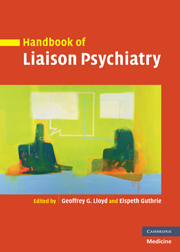Book contents
- Frontmatter
- Contents
- List of contributors
- Preface
- Part I Basic skills
- Part II Common psychiatric problems across the general hospital
- 7 Functional somatic syndromes
- 8 Alcohol problems in the general hospital
- 9 Drug misuse in medical patients
- 10 Sexual problems in medical patients
- 11 Suicide and deliberate self-harm
- 12 Delirium
- 13 Childhood experiences
- Part III Working with specific units
- Part IV Treatment
- Part V Different treatment settings
- Index
- References
9 - Drug misuse in medical patients
from Part II - Common psychiatric problems across the general hospital
Published online by Cambridge University Press: 10 December 2009
- Frontmatter
- Contents
- List of contributors
- Preface
- Part I Basic skills
- Part II Common psychiatric problems across the general hospital
- 7 Functional somatic syndromes
- 8 Alcohol problems in the general hospital
- 9 Drug misuse in medical patients
- 10 Sexual problems in medical patients
- 11 Suicide and deliberate self-harm
- 12 Delirium
- 13 Childhood experiences
- Part III Working with specific units
- Part IV Treatment
- Part V Different treatment settings
- Index
- References
Summary
Introduction
There has been an increasing interest in and awareness of drug problems in the UK over the last decade. This has been reflected in a raft of policy initiatives which include:
Purchasing Effective Treatment and Care for Drug Misusers (1996)
Clinical Guidelines on the Management of Drug Misuse and Dependence (1999)
Substance Misuse Detainees in Police Custody (2000)
Safer Services (1999)
Safety First (2001)
Tackling Drugs to Build a Better Britain (1998)
National Drugs Strategy (1999, 2000, 2001)
Recommendations from the British Association of Psychopharmacology (2004).
Substance problems may present in a variety of different medical settings in both primary care and secondary care. Indeed, no speciality is exempt from drug misusers presenting; accident and emergency, paediatrics, geriatrics, cardiology, dermatology, neurology, gastroenterology, infectious disease, obstetrics, neonatology, trauma and orthopaedic surgery, and general surgery will all be seeing patients who are using, misusing or are dependent on drugs. All psychiatric specialities, including liaison psychiatry, will have their fair share; in particular those dealing with general psychiatry, child and adolescent psychiatry, old age psychiatry, forensic psychiatry, learning disability, and eating disorders, will be assessing and treating patients with substance problems. Thus, the liaison psychiatrist will undoubtedly come across patients with drug problems.
For the purposes of this chapter, we will concentrate on illicit drugs and the misuse of prescribed medication. Thus, we include central nervous system depressants, e.g. benzodiazepines, solvents and gases, opiates and opioids, drugs that alter perception, e.g. LSD (lysergic acid diethylamide), hallucinogenic mushrooms, cannabis, khat, central nervous stimulants, e.g. amphetamines, cocaine, and ecstasy.
- Type
- Chapter
- Information
- Handbook of Liaison Psychiatry , pp. 180 - 220Publisher: Cambridge University PressPrint publication year: 2007
References
- 4
- Cited by



